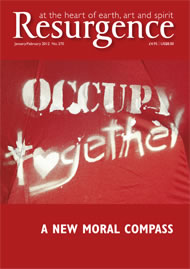In the 1950s, 30% of the world’s surface was covered with forests. By 2005, this had been reduced to just 5%. Humanity, it seems, has been so blinded by hubris that we have carelessly and flagrantly almost incapacitated our life-support system.
Without trees we will not survive as a species and the planet will be rendered uninhabitable. Indeed, despite our technological prowess, trees – those ancient, sacred teachers – still offer the best carbon-sequestration mechanism available, and so may yet be the saviours of humanity, offering us lessons in enlightenment and humility, just as the Bodhi tree gave enlightenment to the Buddha millennia ago.
The Global Forest is first and foremost a book of prose poetry. It is exquisitely written, with great authority: “The ordered wisdom of nature inside the forest still stands tall. It is the majesty that beckons us to keep still and behold a beating heart in a feathered breast. The forest forecasts our future in every breath it takes and every seed it releases into the leaf mold of the forest floor.” This one paragraph alone invites deep pondering – it is so utterly true that the forest forecasts our future – and this is a book to savour.
Diana Beresford-Kroeger begins her paean to trees by examining our molecular kinship: the “sister molecules” of haemoglobin and chlorophyll both have an atom of metal at their heart. In the case of haemoglobin it is iron; in chlorophyll it is magnesium: these twin elements work in harmony, enabling the absorption and emission of both oxygen and carbon dioxide, sustaining all life. This is the first of many parallels Beresford-Kroeger draws between humans and trees. We are much more alike than we realise, and in that, there is ultimately hope for humanity. The author infers that our ancestors knew of this relationship, believing that this is why holly is a sacred plant: its waxy green leaves and blood-red berries represent the bloodlines of the planet.
In The Global Forest Beresford-Kroeger states that the answers to the world’s ills are out there in the forest, and she sets out 40 distinct examples of how trees can “save us”. For example, trees contain a biochemical cornucopia of potent medicines just waiting to be discovered. Natural aerosols emitted by forests are antiviral and antibacterial, which is why we always feel better for taking a walk in the woods. Trees offer a holistic solution to pollution reversal and to stabilising the climate, they could power our economies more sustainably and safely, and they can even bring back the rains to barren deserts.
The chapter entitled Heroes and Hormones: The Broken Forest Is in Our Children’s Tears is a beautiful expression of how deforestation has caused the delicate balance of tree hormones – similar in structure to mammalian hormones – to disperse into our watercourses, and how, together with xenohormones (the synthetic identity of contraceptives and medicines), these have created a new molecular pollution within our bodies.
But Beresford-Kroeger has a plan – a ‘Bioplan’. She goes into some detail about this, and about how new forests should be planted: “To bioplan a forest, epicenter trees are chosen. These kingpin beginning species should be native to the local area… from mother trees that are the oldest and healthiest specimens around. [This genetic material] will hold through climatic change, pestilence, and drought.” Each nation should prioritise the planting of such bioplan forests, which will in time – perhaps just in time – help reverse the ravages of pollution and climate change.
A short review like this cannot do full justice to a work of such passion and does not even touch on the myriad other fascinating aspects of trees that are referenced in this book. Arguably, the most important work any of us can do is to plant trees – and after that, when we rest and when we have a moment for contemplation, maybe to read a few paragraphs of arboreal inspiration from this delightful little book.






